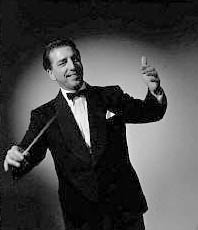It is said that Mantovani received encouragement to become a professional musician from his mother, rather than his father. He began his musical training on the piano, and later learned to play the violin. After the family moved to England in 1912, he made his professional debut at the age of 16, playing the Bruch Violin Concerto Number 1. Four years later he had installed his own orchestra at London's Hotel Metropole, and began his broadcasting career. In the early 30s he formed the Tipica Orchestra and began a series of lunchtime broadcasts from the famous Monseigneur Restaurant in Piccadilly, London, and started recording for Regal Zonophone. He had two US hits in 1935-36, with 'Red Sails In The Sunset' and 'Serenade In The Night'. In the 40s, Mantovani served as musical director for several London West End shows, including Lady Behave, Twenty To One, Meet Me Victoria, And So To Bed, Bob's Your Uncle and La-Di-Da-Di-Da. He was also involved in Noel Coward's Pacific 1860 and Ace Of Clubs; conducting from the theatre pit for artists such as Lupino Lane, Pat Kirkwood, Mary Martin, Sally Gray, Leslie Henson and many others. His records for UK Decca included 'The Green Cockatoo', 'Hear My Song, Violetta' and 'Tell Me, Marianne' (vocal by Val Merrall). Experimenting with various arrangements with which to target the lucrative US market, he, came up with what has been variously called the 'cascading strings', 'cascading violins', or 'tumbling strings' effect, said to be an original idea of arranger Ronald Binge. It became, the Orchestra's trademark and was first used to great effect in 1951, on Mantovani's recording of 'Charmaine', a song originally written to promote the 1926 silent film classic What Price Glory?. The Mantovani recording was the first of several million-selling singles for his orchestra, which included 'Wyoming', (another 20s number), 'Greensleeves', 'Song From Moulin Rouge' (a UK number 1), 'Swedish Rhapsody' and 'Lonely Ballerina'. Mantovani's own compositions included 'Serenata d'Amore', 'A Poem To The Moon', 'Royal Blue Waltz', 'Dance Of The Eighth Veil', 'Toy Shop Ballet' (Ivor Novello Award 1956), 'Red Petticoats', 'Brass Buttons'. 'Tango In the Night' and 'Cara Mia', written with UK record producer/manager Bunny Lewis. David Whitfield's 1954 recording of 'Cara Mia', with Mantovani's orchestra accompaniment, sold over a million copies, and stayed at number 1 in the UK charts for a record (at the time) 10 weeks. It also made Whitfield one of the earliest UK artists to break into the US Top 10. Mantovani issued an instrumental version of the number, featuring himself on piano. This was most unusual in that the instrument was rarely a part of his 40-piece orchestral set-up. Singles apart, it was as an album artist that Mantovani excelled around the world, and especially in the USA. He is said to have been the first to sell over a million stereo units, aided in no small measure by the superb quality of sound obtained by Decca. Between 1955 and 1966 he had 28 albums in the US Top 30. Although he toured many countries of the world, including Russia, his popularity in the LISA, where his style of orchestral offerings were often referred to as 'the beautiful music', was unique. An indication of the US audience's devotion can be gained from a claim by George Elrick, Mantovani's manager of 21 years, that at the beginning of one tour of the USA, the maestro was taken ill and a few concerts had to be cancelled: the prospective capacity audience at one of them, the University of Minnesota and Minneapolis, refused to claim refunds, preferring to retain their tickets for the following year. Mantovani continued to perform throughout the 60s and 70s. He was awarded a special Ivor Novello Award in 1956 for services to popular music.


